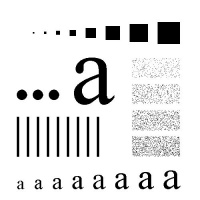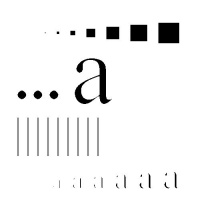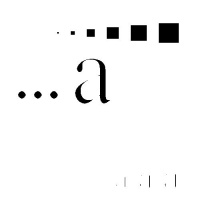This page is a part of CVprimer.com, a wiki devoted to computer vision. It focuses on low level computer vision, digital image analysis, and applications. It is designed as an online textbook but the exposition is informal. It geared towards software developers, especially beginners, and CS students. The wiki contains mathematics, algorithms, code examples, source code, compiled software, and some discussion. If you have any questions or suggestions, please contact me directly.
Dilation and erosion
From Computer Vision Primer
Dilation is an operation that makes black each pixel adjacent to black. Erosion makes white each pixel adjacent to white. By adjacent we understand a pixel that shares an edge with the given pixel. Alternatively, it may be a pixel that shares a vertex. For the intended purpose the difference may be ignored.
Thus, dilation and erosion expand and shrink objects in a binary image, respectively. In the context of this wiki, these operations may be used to reveal “large” features of the image. If a feature disappears after several applications of one of these operations, it is “small” and should be ignored. For example, an object may disappear after a few rounds of erosions. A hole or a tunnel may close after several dilations. Therefore, the number of times it takes to destroy a feature may serve as a measure of its importance. This number is commonly called the persistence or robustness of the feature.
Dilation and erosion are found in Pixcavator's under Tools. Download the free Pixcavator Student Edition here.
Digital discoveries
- Casinos Not On Gamstop
- Non Gamstop Casinos
- Casino Not On Gamstop
- Casino Not On Gamstop
- Non Gamstop Casinos UK
- Casino Sites Not On Gamstop
- Siti Non Aams
- Casino Online Non Aams
- Non Gamstop Casinos UK
- UK Casino Not On Gamstop
- Non Gamstop Casino UK
- UK Casinos Not On Gamstop
- UK Casino Not On Gamstop
- Non Gamstop Casino UK
- Non Gamstop Casinos
- Non Gamstop Casino Sites UK
- Best Non Gamstop Casinos
- Casino Sites Not On Gamstop
- Casino En Ligne Fiable
- UK Online Casinos Not On Gamstop
- Online Betting Sites UK
- Meilleur Site Casino En Ligne
- Migliori Casino Non Aams
- Best Non Gamstop Casino
- Crypto Casinos
- Meilleur Site Casino En Ligne Belgique
- Bookmaker Non Aams




